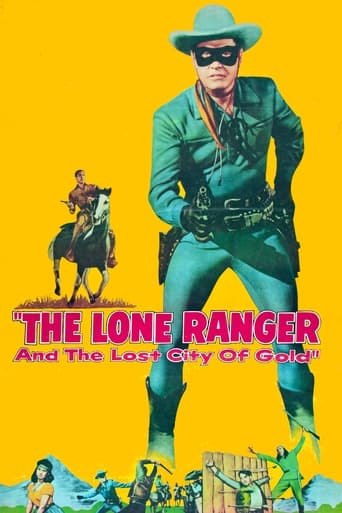The Lone Ranger uncovers a city of gold and plunges into his newest, most exciting adventure!
"The Lone Ranger and the Lost City of Gold," released in 1958, is a cinematic gem produced by Wrather Productions and distributed by United Artists. This film marks the second and final big-screen adventure of the iconic masked hero, portrayed by Clayton Moore, and his faithful Native American companion, Tonto, played by Jay Silverheels. Set against the backdrop of the American West, the movie follows the duo as they embark on a thrilling quest to uncover the secrets of a legendary lost city brimming with gold. The film's vibrant Technicolor visuals and engaging narrative capture the essence of the classic Western genre while adding a touch of adventure and mystery. Directed by Lesley Selander, "The Lone Ranger and the Lost City of Gold" seamlessly blends action, suspense, and moral lessons, staying true to the spirit of the original radio and television series. The plot revolves around the Lone Ranger and Tonto's efforts to thwart a ruthless outlaw, played by Douglas Kennedy, who seeks to exploit the lost city's riches for his own nefarious purposes. Along the way, they encounter a diverse cast of characters, including a young boy and his grandfather, who become integral to their mission. The film's pacing is brisk, with well-choreographed action sequences that keep viewers on the edge of their seats. One of the standout aspects of "The Lone Ranger and the Lost City of Gold" is its commitment to showcasing the strong bond between the Lone Ranger and Tonto. Their partnership is portrayed with depth and authenticity, highlighting themes of friendship, loyalty, and justice. The film also pays homage to Native American culture, with Tonto's character given significant agency and respect. This respectful portrayal adds a layer of cultural richness to the narrative, making it more than just a typical Western adventure. In conclusion, "The Lone Ranger and the Lost City of Gold" remains a beloved entry in the Lone Ranger franchise, offering a nostalgic yet fresh take on the legendary hero's exploits. Its blend of action, adventure, and moral storytelling, combined with the charismatic performances of Clayton Moore and Jay Silverheels, ensures its place as a timeless classic. For fans of Westerns and those who appreciate the enduring legacy of the Lone Ranger, this film is a must-watch that continues to captivate audiences with its charm and excitement.
年份1958
运行时间81 分
类型动作冒险西部
制作国家United States of America

